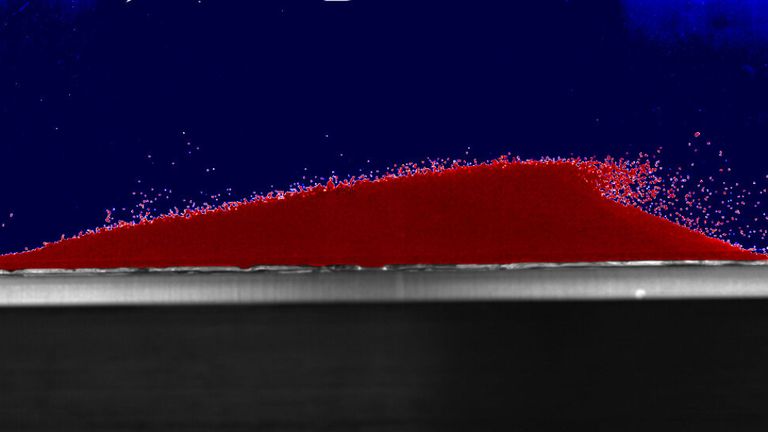Sand dunes are able to "communicate" and interact with one other, according to a study from the University of Cambridge.
They may be inanimate objects but it doesn't mean they're not dynamic - researchers found they not only move but also interact with and repel their neighbours.
This interaction, which the university describes as the dunes communicating, involves them shaping the air flow around them so they push other sand dunes further away.
An experimental "racetrack" was used to test two identical dunes, and although they started close together they got further apart over time.
"This interaction is controlled by turbulent swirls from the upstream dune, which push the downstream dune away," the researchers said.
Sand forms a dune shape when it is exposed to the flow of wind or water and then starts moving downstream with that flow.
Whether in deserts or the sea floor, dunes rarely occur in isolation but develop in large groups, forming patterns known as dune fields or corridors.
"It's well-known that active sand dunes migrate," the researchers said.
"Generally speaking, the speed of a dune is inverse to its size: smaller dunes move faster and larger dunes move slower," they added.
However, the relationship between dunes within a particular dune field or corridor is not fully understood.
"There are different theories on dune interaction: one is that dunes of different sizes will collide, and keep colliding, until they form one giant dune, although this phenomenon has not yet been observed in nature," said Karol Bacik.

Image:Sand dune in experimental flume setup. Credit: University of Cambridge
"Another theory is that dunes might collide and exchange mass, sort of like billiard balls bouncing off one another, until they are the same size and move at the same speed, but we need to validate these theories experimentally," said Mr Bacik, from Cambridge's department of applied mathematics and theoretical physics.
Research by Mr Bacik and his colleagues suggests both theories are problematic.
"We've discovered physics that hasn't been part of the model before," said Dr Nathalie Vriend, who led the research.
The researchers started with two dunes of the same volume and same shape.
As the flow in the racetrack moved across the two dunes, they stated moving too.
"Since we know that the speed of a dune is related to its height, we expected that the two dunes would move at the same speed... However, this is not what we observed," said Dr Vriend, who is based at the BP Institute for Multiphase Flow.
Initially, the front dune moved faster than the back dune.
But as the experiment continued, the front dune began to slow down until the two were moving at almost the same speed.
The researchers discovered the pattern of flow across the dunes was different. The front dune deflected the flow and generated "swirls" on the back dune, pushing it further away.
"The front dune generates the turbulence pattern which we see on the back dune," said Dr Vriend.
"The flow structure behind the front dune is like a wake behind a boat, and affects the properties of the next dune."
The researchers say the next step of their research was to find evidence of large-scale and complex dune migration in deserts, using observations and satellite images.
"By tracking clusters of dunes over long periods, we can observe whether measures to divert the migration of dunes are effective or not."
Their research is published in the journal Physical Review Letters.
 简体中文
简体中文

